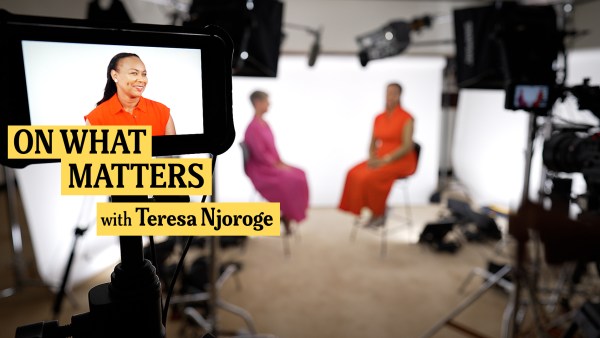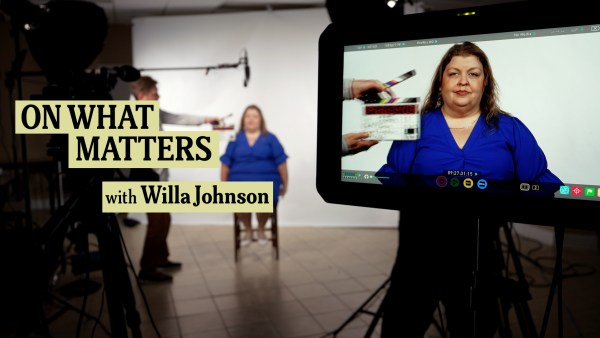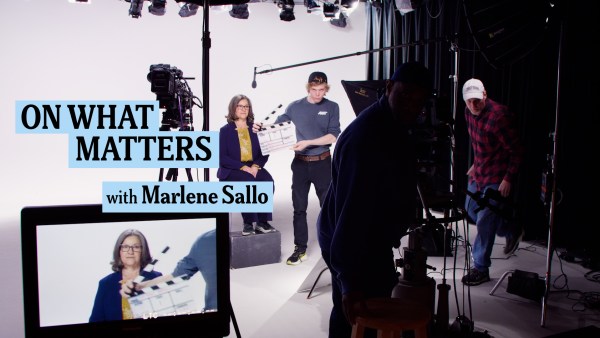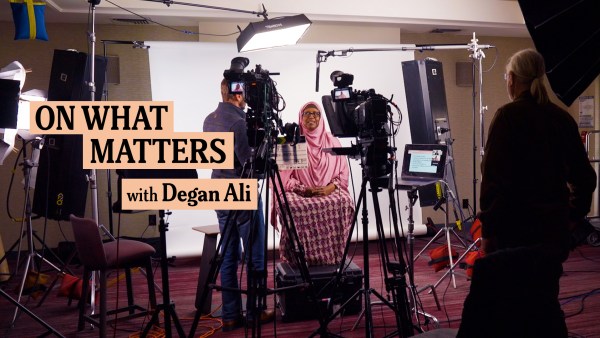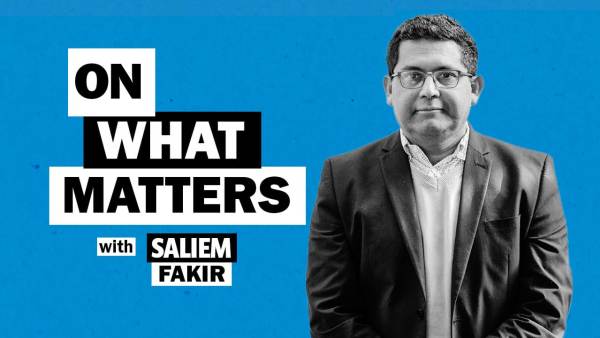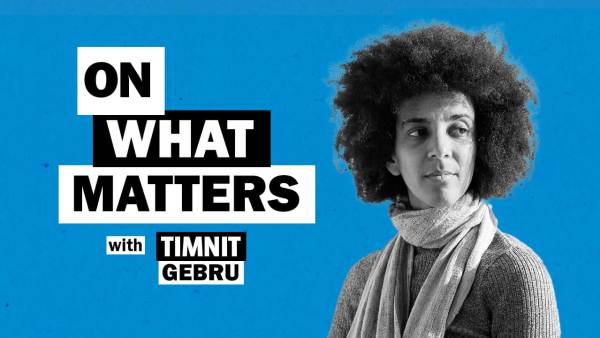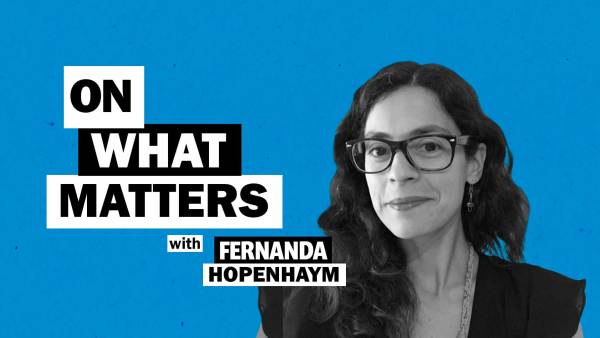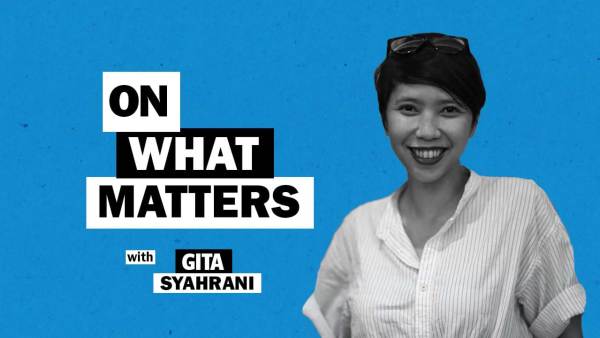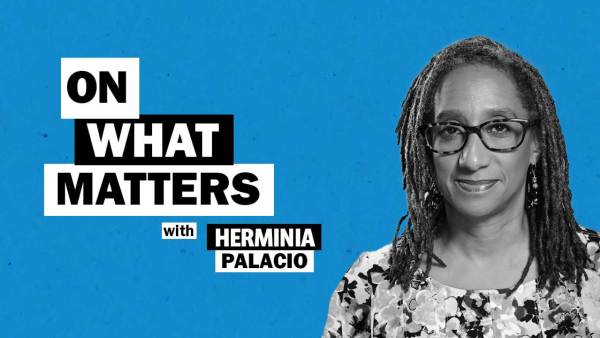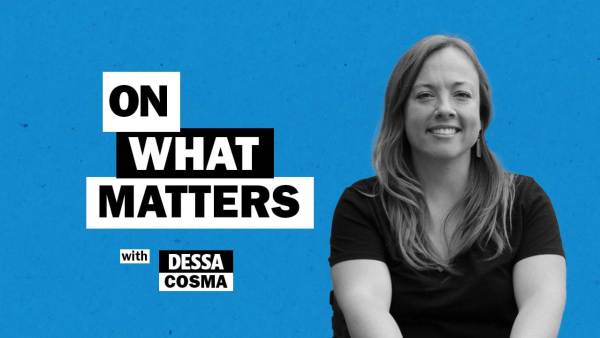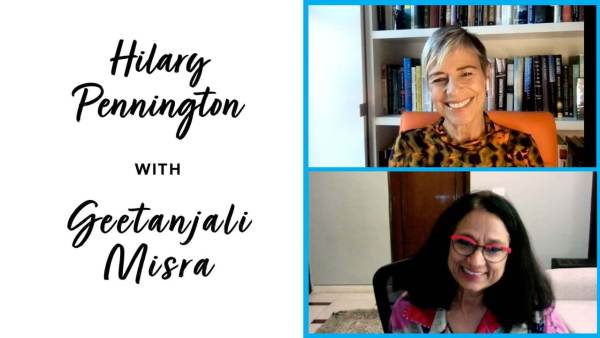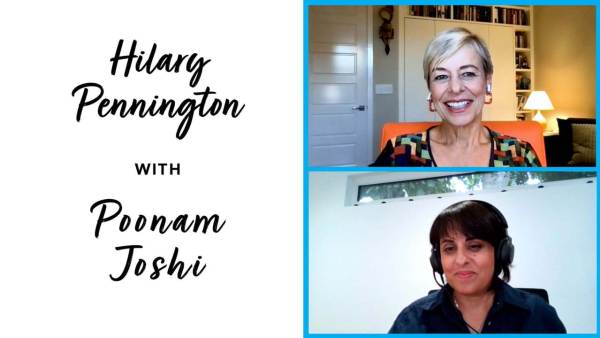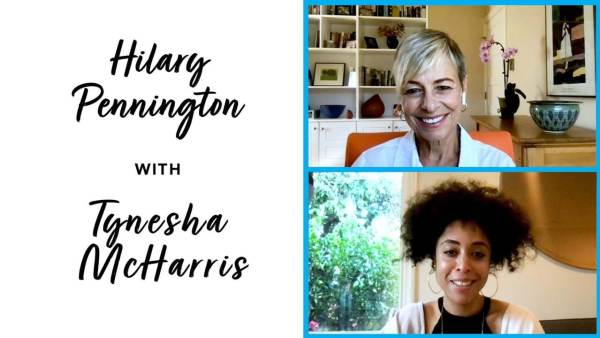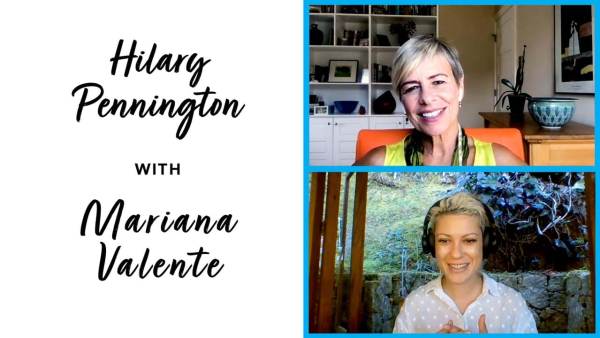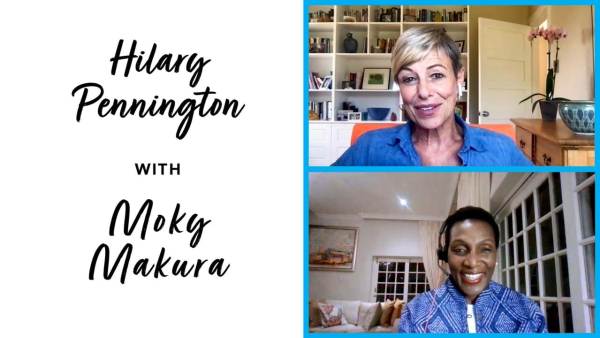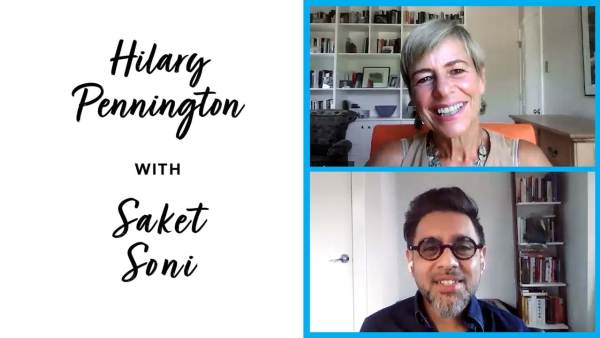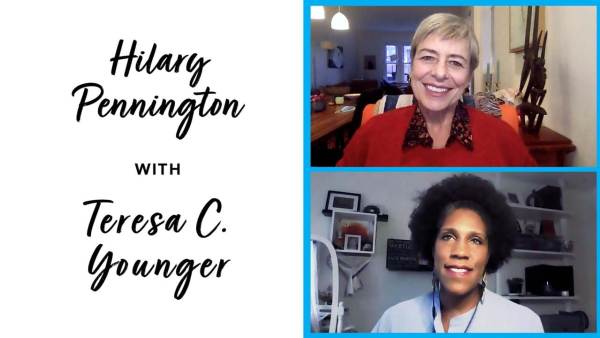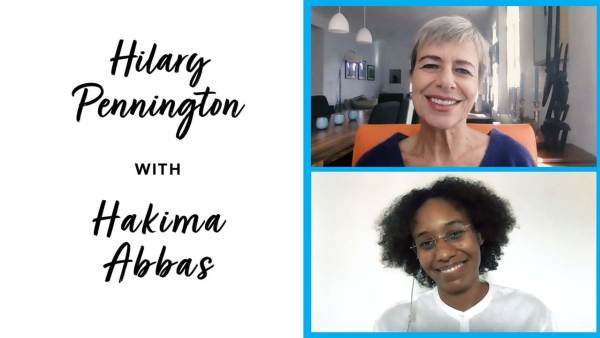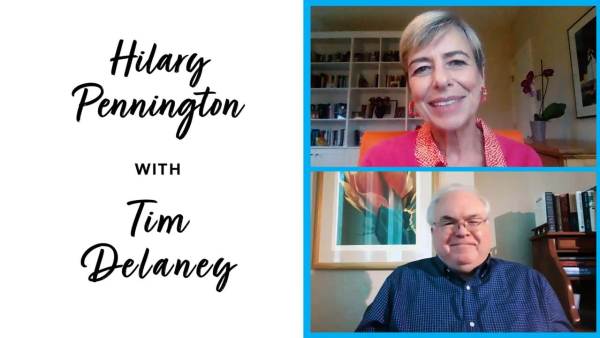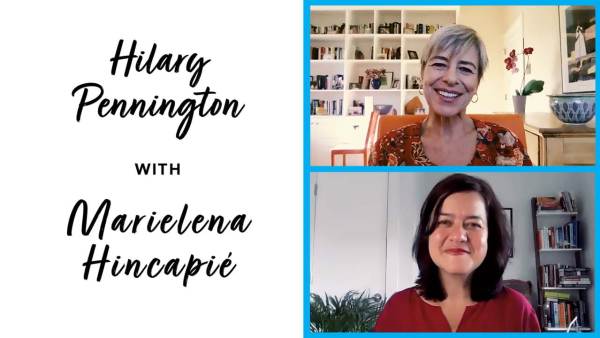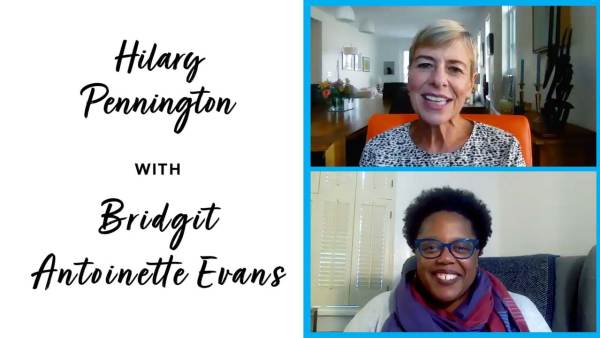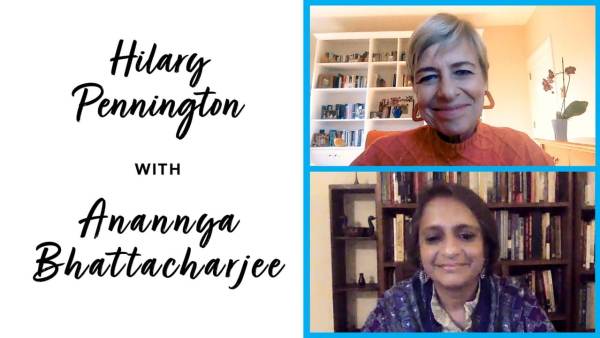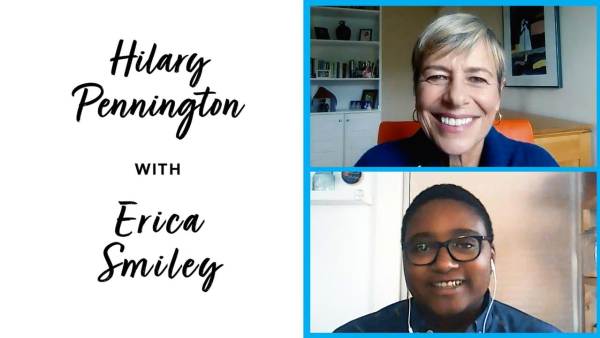Advancing Community-Based Violence Intervention With Jamila Hodge and Sarita Gupta

Transcript
SARITA GUPTA: Hi! I’m Sarita Gupta. Thanks for joining us for the latest conversation in our “On What Matters” series. I’m the vice president of U.S. programs at the Ford Foundation. I’m a brown-skinned, South Asian woman with salt-and-pepper hair. Today, I’ll be speaking with Jamila Hodge about promoting a trauma-informed public health response to violence. Welcome, Jami.
JAMILA HODGE: Thank you, Sarita. I’m so excited to be here. As you said, I’m Jami Hodge, and I’m the CEO at Equal Justice USA. And I’m a Black woman with loc’d hair, and I’m wearing glasses.
SARITA GUPTA: It’s wonderful to have you here. Let’s learn a bit about your work, Jami. Why has the current criminal justice response to violence been ineffective? How does EJUSA address those gaps in its work by using a public health response to violence?
JAMILA HODGE: So Sarita, I answer that question through the lens of someone who has spent 12 years working as a prosecutor. So not just having a seat up close to our criminal legal system, but someone who’s spent a lot of time as an active participant in it. And when we think about our criminal legal system, there are essentially three questions it’s going to answer. The first is, “What crime was committed?” The second is, “Who committed it?” And then the third is, “How do we punish them for it?” And so with that being the focus—and that’s really from everywhere, from policing, through prosecutors, through our court system—what those questions don’t center are the folks who’ve been harmed: victims and survivors. And those questions don’t focus on what actually drives violence. It’s very much focused on, “What do we do after the fact? Who do we track down? Who did it? How do we figure out what crime this is? And then how do we punish for it?” So the work that we do at EJUSA, that I feel so privileged to be a part of, is really recognizing that for us to truly address violence, we have to center the folks who’ve been most impacted, and that’s victims and survivors. And for us, that’s work that we started early in our history as an organization. We began as a death penalty abolition organization, working to end the death penalty. We’ve been part of the last 11 states to end it. But the way we helped—beginning, you know, more than 20 years ago, to help shift public opinion—was by organizing with Black and Brown murder victim family members. So elevating the voices of victims and survivors, victims’ families, survivors families, who had been marginalized in the process. And that’s very much how we do our work today around building community safety. It’s really with, by organizing with, partnering with those who’ve been most impacted so that we’re asking different questions and answering different questions than those the system attempts to answer. We also do our work through a public health lens, through our restorative justice work. And so, that’s the work that really centers the victim in an incident, and it really is a process of bringing them—first separately, the victim, and then the person who caused harm, separately—to really begin to assess what needs there are, for both the victim and for the person who caused harm. And then there’s work that then comes together in a community conference where they’re able to meet together. They come up with a plan, and so what we find is restorative justice allows a pathway to healing versus a pathway to punishment. So those are just a few examples of the way we do our work through a public health approach.
SARITA GUPTA: That is incredible work that you described. So can we just take a moment, and can you define for us what restorative justice means?
JAMILA HODGE: Restorative justice is an alternative, in most places, to pursuing a case through the criminal legal system. So I’ll just use our work for an example, at the Restorative Justice Project that we house, we work specifically with youth and young adults. And so what happens is, at the point that a case is brought to a prosecutor, and again, where we’re really trying to focus on cases where there’s a victim, someone who has been harmed. We’re talking about more serious cases, and this is done with the victim’s agreement, right? That instead of just moving the case forward to either a trial, or a plea, and then moving towards sentencing, that there’s this opportunity to have a different path. And that different path really allows, first of all, the victim to be centered in terms of working with a community-based organization to figure out what they need. And often what we find is when someone has experienced violence, there’s a lot that’s needed just to create a sense of safety again. There are often a lot of questions about, “Why did this happen? Why me?” That go unanswered in a criminal legal process, that there’s an opportunity to actually have those questions raised and answered in a restorative process. But in addition to working with the victim, there is work that’s done with the person who caused harm. And again, it’s really understanding that we’re not going to just say this is a bad person that we’re just going to put away. We’re going to actually ask some questions through a trauma-informed lens, learn about their story, and often that’s how we get at those root causes. “What drove this? What caused you to do it? How do we set you up so that you don’t do it again? How do we help you do the internal work that you need to do and support you in that?” And then they come together for a conference, where there’s an actual meeting, where those questions and a dialogue can be had, and that conference leads to an agreement. So, one of the things that the system promises, right, is there’s accountability. This is how we get justice, and, you know, accountability for the victim. But that accountability doesn’t, in the system, actually always require acknowledgment by the person. You can be sentenced, and go to prison, and never acknowledge what you did. And it also doesn’t often require repair. And that’s the difference in a restorative process. It’s accountability that repairs. And that agreement is, “How do you, to the very best of your ability, make repair for the harm that you caused?” And by having an agreement, it allows some flexibility and some creativity, but that really centers the needs of the victim. And what we find is that it works. You know, the victim satisfaction is significantly higher who go through restorative processes. Recidivism rates are significantly lower for people who go through restorative processes. So it’s an important alternative that works.
SARITA GUPTA: What I love about that definition, and that approach, is it is seeing people as whole people who have experienced harm and who have harmed. And so it’s a beautiful orientation. So let’s talk a little bit about how your work addresses issues of race and structural inequities, that too often go ignored by our current system.
JAMILA HODGE: That’s such an important question. I personally feel like, if I am in a room and we are talking about, whether it’s criminal justice reform or transforming responses to violence, if we have not talked about racial justice, then we are missing the mark. For us to really address and change both our current responses—which is the, you know, the criminal legal system and so many people who are ensnared—and also build up alternative responses to, “How do we get to root causes of violence?” We have to begin with the foundation and understanding that so much of how our criminal legal system came about is rooted in racial oppression. We know that, history teaches us from the 13th amendment that abolished slavery, except as punishment for crime. And so learning and understanding that history and making sure that we bring that focus into any conversation, because if we’re not talking about it, even solutions can actually exacerbate the racial disparities that we see. So part of the way we do that is, again, in who we center in our work, and again, that is working with the communities who are most impacted. And so not only do we see racial disparities in our criminal legal system, there are so many statistics that bear that out. Whether that’s, you know, making up 40% of the population on death row when we’re about 14% of the population, I’m speaking specifically about Black people. We know that at pretty much every point of a police encounter that Black people are more likely to be stopped, more likely to be searched if stopped, you know, the punishment that comes is more harsh. There’s a lot of data to support those racial disparities. But I think what we talk less about are the racial disparities in who’s impacted by violence. There’s recent data that shows that Black people are 12 times more likely to be the victim of gun violence. There’s recent data from the CDC that shows that the leading cause of death for Black men and boys under the age of 44 is homicide. So knowing that our communities are disproportionately impacted, not just by the system, but by violence, and then really organizing with and working with, in the communities where violence rates are highest, is how we do our work. And knowing that, again, those closest to the problem know what they need to be safe. So how do we support and help get resources to those communities? Because we know poverty is a driver of violence. And how do we resource these solutions that are working on the ground to address the drivers of violence?
SARITA GUPTA: I really appreciate that very important point about addressing the real drivers of these structural inequities, because to your point, you can in fact come up with solutions that just reinforce those inequities. So I love those examples, thank you. So tell us, how does this work try to change the larger narrative about the essential ingredients of community safety?
JAMILA HODGE: Yeah, again, just speaking from the experience I had being in the system, the system is really set up in its adversarial way, with this false narrative that the way we get to safety is that we have to protect us quote-unquote “good people” from the quote-unquote “bad people.” And so, so much of the system is about identifying who caused the harm, punishing them, and by punishing them, we mean by putting them away, incarcerating them, removing them from community, removing them from society. And so, there’s a narrative that drives that, and so many people that I admire talk about this, you know, whether that’s going all the way back to Dr. Martin Luther King, that there was a lot of efforts in the civil rights movement to change laws, but not necessarily to change hearts and to address the underlying narratives. And as we see right now, laws are under attack, and laws are consistently, even right now, being rolled back. We have got to change hearts, and that means we’ve got to address the narrative that we never addressed. You know, part of the narrative that justified slavery was that Black people are dangerous, that Black people are violent, that they need to be controlled. And, again, we abolished—except as punishment for crime —abolished slavery, but we never tackled that narrative of having violence and dangerousness attached to Black skin. So one, we’ve got to be willing to call out the false narratives that we need to tear down. We’ve got to uproot those trees, right? If we think of narrative as a forest and trees as the messages, and I get this from, I think it’s the Color of Change description of what narrative power means, so we’ve got to uproot those, those false messages, but then we’ve got to plant the new trees. Right? And we’ve got to show people that, yes, we all desire safety, but let’s first redefine it. Safety is more than just the absence of violence. Safety, when we think about where we feel most safe, we’re talking about thriving communities, we’re talking about green spaces, we’re talking about places where our children can play, places where we feel like we’re known by name, we can walk our streets. So, when we first broaden the definition of safety so that it’s not just the absence of violence thriving, but making it about what communities need to thrive, that requires something different of us. That requires us to resource differently, not just sort of buying into this false narrative of good people versus bad people. So, all of this work really is about one addressing those false narratives, but then we’ve got to tell the stories of what’s working. Newark, New Jersey, is a place we reference often in our work because it’s where we’ve done our deepest work, and it’s a place where there is a thriving public safety ecosystem that centers community members and centers grassroots partners who are doing the hard work of addressing drivers. They had a 63-year-low in homicides. It is pretty incredible, the gains that have been made there, but we have to tell that story. So many people don’t know that there are solutions out in the world that are working. So when violence happens, and politicians and leaders have to be able to address it, too often we revert back to our same old, same old status quo. And we’ve got to tell the story so that they know that we can respond with something more than more police and more punishment.
SARITA GUPTA: There was so much you just offered in that, the images in my head of uprooting the false narratives and planting the new narratives, and all that you said about how important and critical it is to redefine what safety means. I love that, that it’s not just simply the absence of violence, but it’s about thriving, and what does thriving communities mean? So what is the power and potential of greater investment in community violence intervention strategies?
JAMILA HODGE: So when we think about solutions that work, right, that drive down violence, community violence intervention and prevention is one of those important strategies. And we have seen a historic investment by the federal government, really for the first time, in these strategies. But we need so much more, especially when we spend $300 billion annually on our current systems. So the investments we’ve seen are really just a drop in the bucket compared to that. But what it is, is essentially having a different alternative to police when violence is happening in real time. And there’s lots of parts. Community violence intervention and prevention is a broad sort of catchall. There’s lots of things that fall within that larger description. But I’m going to focus just for a second on frontline violence intervention workers, who really show up in the moment when violence is happening or about to happen or in the aftermath of violence. And these are folks who have the real experience, so credible experience. So usually they are from the neighborhood, they have in, some point in their life been involved in, you know, often the violence or maybe it’s in the neighborhood crews or, whatever. But they have that sort of street credibility because they’ve been there. They’ve walked in the shoes. And they have a passion for making sure that people don’t end up with the consequences that many of them have. Many of them have served time or have been justice-involved, and they want something different, particularly for our young people; and so having this important alternative, and again, I point to Newark as another incredible example of this, in this sort of great success of driving down shootings and homicides. The Newark Community Street Team, which that frontline violence intervention work in Newark, is an incredible, important part of how these successes that we’ve seen have happened. And whether that’s doing safe passage in accompanying kids to school in neighborhoods where they don’t necessarily feel safe or, again, knowing because there’s cooperation with the police department, you know, when that, call comes in that they can be deployed, that it’s not always the police that need to be deployed. And to be able to do, again, through more of a relationship lens as opposed to a punishment lens. How do we go in? Know who’s involved? Figure out what the needs are? How do we de-escalate in a way that’s not going to lead to a police shooting or some other, often very dangerous and could be deadly response?
SARITA GUPTA: Wow, that’s really powerful, and so needed, because I think so many of us have followed stories that have resulted in unnecessary violence. So we’re going to actually go to some of our audience-submitted questions, and our first question is from Stanley from the New York City Department of Youth & Community Development, who asks, “What are some strategies youth development workers can incorporate that are trauma-informed?”
JAMILA HODGE: Thank you for the question, Stanley. It’s a great question. And what I appreciate about a trauma-informed lens, which again, is so different from the way our system operates, is it makes us ask different questions, right? If you’re using a trauma-informed lens, instead of making it about the person—so, “What did you do?” or “Why did you do it?”—we ask the question, “Well, what happened to you?” Right? And we try to learn more about their story, about their background, about what they’ve experienced, because one of the things that I know for sure—and saw, again, because I was a participant in the system—is, I never had an experience where someone caused harm who had not themselves first been harmed. And usually that victimization began in childhood. And so trauma, we know, is a driver of violence, and when we don’t meet people, we don’t meet those needs, and trauma goes unaddressed. We don’t provide pathways to healing. We shouldn’t be surprised that unhealed trauma can lead someone to be someone who is causing additional harm or harming others. So in the youth space, I just think about, there are so many incredible examples of how people are doing this. One of our close partners in Newark is Al-Tariq Best in the HUBB, and he uses music, and he has a studio where youth can come in. They can lay their beats, they can record a podcast, they can learn videography, but it’s also a space where they hold groups. It’s also a space where they have counselors. It’s also a space where they will get mentors and have a chance to build real relationships, where you can get to know the whole person as you bring them in around an interest and are able to engage them on their interest. But ultimately it’s about, you know, truly caring for the folks that we are trying to serve, regardless of what they’ve done, right? And that’s why we have to combat that narrative of good versus bad. It’s really understanding we are all capable of both, and there’s so many structural factors that influence which choices we make.
SARITA GUPTA: Newark is just incredible, in terms of, to your point earlier, of the examples of some of the really interesting and new approaches to community safety. But that was such a lovely example that you offer. Thank you. So at the Ford Foundation, we have a focus on achieving justice for disabled communities, so our next question comes out of that work: “Given that we know gun violence both creates disabilities and exacerbates them, how can disability justice organizations be engaged to advance community safety?”
JAMILA HODGE: Thank you, another really important question. And what it does for me is flag the fact that we’re not doing enough to include the voices and experiences. While there’s a very robust disability justice movement and folks who are working in that space, I think often we’re too siloed. And so one of the things that we need to do is just make sure that we are reaching out, and making sure we’re hearing directly from those who are doing that incredible work, because there’s overlap, clearly, as the question indicates. And so I do know of, there’s one organization who comes top of mind, Activating Change, which does that work at that intersection of criminal justice reform and disability justice. So I just appreciate the question for lifting it up, and really feel personally challenged that even in our work, we need to do better and make sure that we are reaching out and hearing from all impacted communities.
SARITA GUPTA: That’s terrific. Well, Jami, I am so grateful for your leadership and for the work of EJUSA. I know this work takes time and can be really, really tough. So as we close out our conversation, I wonder if you can share with us what keeps you motivated?
JAMILA HODGE: It’s so important because it is, it is tough work. And not only for me personally, but I think about often our partners that we support and, just all they go through in trying to do that frontline work, trying to get resources, trying to manage all the things. And so for me, there are a couple things. You know, I’m a mom of two girls, Nylah and Zaria, who are nine and eleven, and they motivate me every day to want the world to be a better place for them, as they will grow up as Black women in this space that often doesn’t invite them in, doesn’t want to see them, doesn’t want their input, wants to keep them small. How do we change that? I have Black nephews, brothers, people I care about, and I know how Black men are often feared and targeted. And so just wanting the world to be better for them. But then, the other thing that motivates me is that I truly feel like—and I find this with so many people I get to partner with in this work—that it’s not a job, it’s a calling. I truly could not do this work if I had to do it in my own power, you know, I know that I am walking out a purpose that God gave me. And so for me to do this work, I have to rely on his strength. I cannot do it alone. So that definitely keeps me here, keeps me motivated, keeps me strengthened in the tough times.
SARITA GUPTA: That’s just beautiful. Thank you. Thank you, Jaime, for a great conversation. And to those tuning in today, we hope you’ll join us for the next “On What Matters” episode. Stay tuned for more information.
Accessibility Statement
- All videos produced by the Ford Foundation since 2020 include captions and downloadable transcripts. For videos where visuals require additional understanding, we offer audio-described versions.
- We are continuing to make videos produced prior to 2020 accessible.
- Videos from third-party sources (those not produced by the Ford Foundation) may not have captions, accessible transcripts, or audio descriptions.
- To improve accessibility beyond our site, we’ve created a free video accessibility WordPress plug-in.
Welcome to “On What Matters,” a conversation series in which Ford Foundation leaders talk to our social justice grantees on the frontlines of change.
In this episode, Sarita Gupta, Ford’s vice president of U.S. programs, interviews Jamila Hodge, CEO of Equal Justice USA, a national organization that works to transform the justice system by promoting responses to violence that break cycles of trauma.
Jamila outlines the importance of community-based responses to violence that take a trauma-informed approach and meet people where they are.
Learn more about EJUSA at: ejusa.org/
